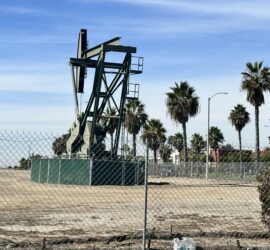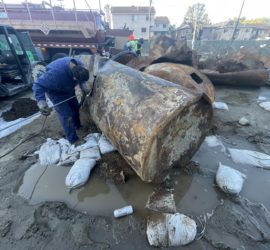Soil Management Plan & Soil Excavation Plan
A Soil Management Plan or Soil Excavation Plan provides guidelines for grading and construction projects at sites with potential contamination issues or ongoing remediation. At a minimum, the document comprises a site-specific health and safety plan, an excavation boundary site map, and a series of cross-sections. Moreover, a soil management plan provides a description of subsurface anomalies from Phase II Environmental Site Assessments and geophysical surveys. Lastly, one can expect guidance on permitting requirements and the legal disposal process, as well as confirmation sampling and backfilling protocol. Updated April 9, 2024.
Environmental Overview of the Soil Management Plan
Excavation projects are often complex in nature, due in part to substantial regulatory requirements. And multiple agencies oversee each stage of work along the way. Permit applications are necessary to dig and drill. To close such permits, consultants must perform soil sampling procedures. The final lab results must confirm the lack of contamination. Moreover, there is a requirement to show proof of special handling and legal disposal of the excavated materials, as well as proper backfilling. Furthermore, there are structural concerns for the surrounding buildings and properties. Thus, consultants must demonstrate and implement proper lateral support systems, in accordance with local grading department guidelines.
Soil Management Plan Safety Procedures
Lastly, worker and public safety is a highly important aspect of this work. All aspects of the project must comply with OSHA trenching and excavation safety guidelines, as well as a professional Health and Safety Plan (HASP). A Soil Excavation & Management Plan ensures the work is done correctly, safely, and in compliance with all regulations at every stage.
Project History & Site Background
The first topic a Soil Management Plan must include is a record of the job-site history. This information is helpful for project optimization. For instance, documents indicating the presence of underground storage tanks (USTs) or hydraulic lifts often arise during a Phase 1 Environmental Site Assessment. If other reports are available, such as a Geophysical Survey or a Phase 2 Environmental Site Assessment, consultants may be able to reduce the scope of work, cost, and timeframe for excavation. The property owner should make all these reports available, along with any other pertinent information.
Soil Excavation Plan & Responsible Parties
The next pillar of a Soil Management Plan is contact information. This includes a list of names, titles, and email addresses as well as the direct phone numbers of individuals, agencies, and private companies in association with the project. Typically, the plan names the property owner, along with any tenants, managers, or agents, as well as the excavation contractor, environmental professional, and key contacts. And, if the site is already under the oversight of a regulatory authority, then the applicable contact information of agency caseworkers and staff is available.
Forms, Registration, Permits, Etc.
There will likely be no shortage of paperwork in association with environmental remediation and excavation projects. Nonetheless, the environmental professional consultant forming the Soil Management Plan will determine site-specific requirements. For example, the following is a list of general prerequisites that one may expect for the removal of underground tanks in the Los Angeles area of California. Los Angeles requirements are a prime example of this outline because the city offers one of the most comprehensive processes for soil excavation projects. And other jurisdictions around California and across the nation typically offer equal or lesser requirements.
Grading & Excavation Permit
In the City of Los Angeles, as well as other metropolitan cities in the United States, consultants have the requirement to initially obtain an excavation permit. This is for the process of ensuring a proper dig-out out of the underground tank and backfilling the void. The responsible party will be the final signer of the excavation permit application. A proper Soil Management Plan outlines these criteria, as well as it’s support and pre-requisite permits.
AQMD 1166 Plan
Prior to commencing with fieldwork in most California jurisdictions, a Various Locations Rule 1166 Contaminated Soil Mitigation Plan becomes a requirement with the Air-Quality Management District (AQMD). A soil excavation management plan and health and safety plan are typical components of the site-specific Rule 1166 permit. Similarly, other states across the country administer similar requirements through their respective air quality management agencies. In such cases, environmental consultants file a Various Locations Rule 1166 Contaminated Soil Mitigation Plan. The responsible party will be responsible for signing the AQMD Plan.
Shoring / Excavation Design, Plan & Construction
When necessary, a Soil Management Plan and Soils Excavation Plan will determine the need for shoring. Per OSHA requirements, a shoring plan with proper lateral support is a requirement for some UST removals. The shoring plan would need to be under the guidance of a professional geotechnical engineer, and have the approval of the local city or county grading department, state Department of Industrial Relations (or OSHA), and potentially more agencies.
Public Right-of-Way Encroachment Permit
As a result of an excavation pit location that is within the public right of way, one must apply for, and obtain a public encroachment permit. And the Soil Management Plan documents the absolute requirement of this process. An encroachment permit application may require many of the same components as a tank removal permit. Additionally, one can expect to provide a certified traffic control plan and a requisite shoring excavation plan for lateral support. Soils management plan consultants oversee and/or obtain an encroachment permit with the respective oversight agency to perform work on any public right-of-way. And this typically has a limitation of working hours that are outside of rush-hour traffic. For instance, from 9:00 AM to 3:00 PM. Moreover, a professional traffic control plan becomes necessary for permit approval in most cases. As usual, the responsible party (or property owner) will be responsible for signing the permit.
Fire Department UST Removal Permit
With most underground storage tank removal projects, excavation fieldwork and an excavation plan are a requirement. As a result, the environmental consultant must obtain a UST Removal Permit for the excavation project, from the local City and/or County Fire Department. Consultants can perform all aspects of the permitting process, as well as the fieldwork. However, the final permit is to be on behalf of the property owner and/or the responsible party.
County Department of Public Works – UST-Registration
If the existing UST is not on record with the local Department of Public Works or County UST Program, it will be necessary to first register the UST. This is a prerequisite to the removal permit. Moreover, this process is a requirement in order to achieve a final “No Further Action” certificate from the regulatory oversight agency.
County Fire Departments – Health Hazardous Materials Division
Additionally, local County hazmat offices may require regulatory oversight for the underground tank registration and removal process. For instance, in Los Angeles County, the Fire Department comprises a Health Hazardous Materials Division, which also has an interest in teaming up with the other branches of the County, for environmental excavation projects.
Facility Information Form (Including Mandatory BOE Number)
Among the other items, the Facility Information Form requires that the owner of the Subject Site (and UST) apply for an account number with the State Board of Equalization. This “BOE Number” is also known as the “UST Maintenance Fee.”
Tank Information Form
In some cases, the nature and size of the subsurface anomaly undergoing excavation are uncertain. For example, geologists may understand a tank exists under a property. However, the exact size, depth, volume, and material thickness is uncertain. In such a case, the oversight agencies still require a generalized “tank information form” based on reasonable presumptions. Additionally, this information might require submittal to the State Environmental Reporting System.
EPA Identification
In order to properly dispose of any soil or liquid waste from a contamination excavation, one must obtain an official EPA identification number for the site. This number is essential to transportation, as well as the disposal processes, of soil contamination excavation. Ultimately, the responsible party will be the liable entity that is responsible for signing the EPA I.D. application.
Soil Waste Profile & Materials Waste Transportation Manifest
Upon obtaining an EPA identification number, environmental consultants may accordingly dispose of the resulting waste from an environmental excavation project. To do so, consultants must set up a waste profile, under the direction of a professional geologist or engineer. In order to transport materials, a transportation manifest is necessary. Issuance of a waste profile and transportation manifest relies on recent and available laboratory analytical results from the excavation.
Environmental Remediation Oversight (If Contamination is Found)
The soil excavation fieldwork is typically overseen by the permitting agency caseworker. And if significant contamination is apparent at the site, the permitting agency isn’t likely to close the permit. In fact, as a result of the remaining contamination, a new case with a higher-ranking environmental oversight agency is likely to commence. For instance, according to the County of Los Angeles Fire Department, if contamination is discoverable, the agency can report a clean-up case to the State Water Board or the Department of Toxic Substance Control (DTSC). And that case cannot close until all proper clean-up and remediation actions are complete. Upon the final completion of all work, and confirmation of sampling results to the satisfaction of the regulatory agencies, a site closure letter and “No Further Action” certificate are issued.
Health & Safety Plan
Another component of a comprehensive Soil Management Plan, that must be in place before the start of work, is a site-specific Health and Safety Plan (HASP). The main purpose of this document is to identify job site hazards and make recommendations to reduce exposure to hazards. Additionally, the Health and Safety Plan prescribes the appropriate personal protective equipment (PPE) to be worn by workers on-site. Additional safety considerations include notifying the Underground Service Alert (USA) before digging so that buried utility lines are identifiable beforehand.
Maps and Figures
A Soil Management Plan will also include visual representations of the subject site and surrounding areas. These may include topographic maps, aerial photographs, site layout diagrams, and site plans by specialists such as land surveyors or geophysicists. These reports aim to provide as much information as possible. And to ensure everyone on the project has a proper understanding of the site and subsurface conditions.
Type of Equipment
All parties to a project must know about the types of equipment being used on an excavation job. Typical types of machinery are backhoes, dozers, and excavators. These are convenient choices because they can dig, backfill, and hoist a tank out of the ground. However, for larger underground tank excavation projects, cranes are typically present. Knowing as much as possible about what exists underground on-site will help to inform the environmental consultants about the proper equipment to use. And the applicable vehicles and equipment are generally a topic of discussion within the Soils Management Plan and Health and Safety Plan.
Scope and Schedule
Excavation logistics and methodologies vary from one project to another. However it is important for the Soil Excavation Management Plan to clearly outline the scope of work and the nominal schedule on a task-by-task basis. This part of the plan details the dimensions of the excavation pit (or pits), estimates the amount of waste soil, and outlines any structural precautions and/or requirements. In fact, many of these factors additionally depend on prior laboratory data, identifying the chemical content, type, and density of the on-site soils. The engineering process is to ensure that the excavation pit does not collapse in on itself and that no surrounding structures are at risk. For example, if the excavation is adjacent to a roadway, there is a mandatory requirement for a lateral support system to prevent the collapse of the soil underneath the road.
Storage, Analysis, and Disposition of Soil
By law, all excavated soil must be kept on-site with proper lining and containment. This occurs until laboratory analysis and waste profiling are complete. The Soil Management Plan also outlines the storage process of soil waste, as well as handling. The plan will also instruct how many confirmation samples to collect. Lastly, it designates the laboratory certification for analysis and prescribes the tests to perform. This part of the Soil Excavation Plan also provides the next course of action, depending on whether the soil is clean or not.
Backfilling
If the burden from the soil excavation is free of petroleum products and other hazardous materials, it can apply as backfill material within the excavation pit. However, proper geotechnical and engineering geology methods are a requirement to ensure proper backfilling. Additional clean soil may need to be brought in to fill the hole. The Soil Management Plan will include procedures for backfilling as well as the ASTM methods for compaction. This includes calculations to estimate the adequate relative density. Furthermore, a soil excavation plan will prescribe mechanical compaction testing procedures. This assures that all work will meet the criteria of the ASTM standards. As a result, the final ground surface remains without risk of settlement or collapse.
Contaminated Soil
Additionally, the Soil Management Plan will explain how to handle soil with confirmation test results that conclude there is contamination. Following hazardous materials guidelines, the soil waste requires transportation off-site, for disposal or treatment purposes. The Soil Excavation Plan will detail the logistics, permitting requirements, and recommendations for dealing with soil waste. The backfill procedures will then commence using clean backfill soil with certification.
Final Reports and Case Closure
Finally, the Soil Management Plan outlines the expectations for a final report and reports to all parties and affiliates. The environmental consultant who prepares the Soils Management Plan may be the same consultant to performs the fieldwork and writes the final report. It is important to remember that a Professional Geologist or Engineer oversees the work, certifies the reports, and navigates the regulatory compliance. For instance, agency compliance typically requires the approval of design work plans prior to fieldwork. Similarly, final reports are an expectation at the completion of fieldwork. As a result, a “No Further Action” letter for case closure is issuable. These are important considerations to keep in mind when choosing an excavation contractor or environmental consultant. Every project will be different. However, a successful excavation always begins with a comprehensive Soil Management Plan and Soils Excavation Plan.




